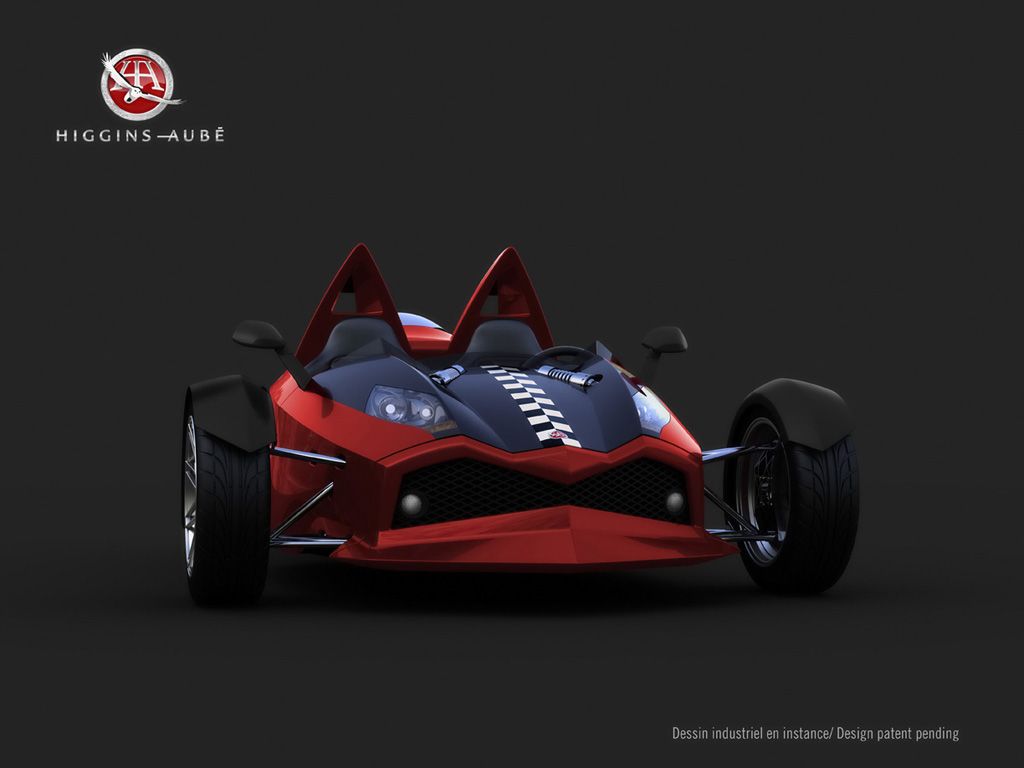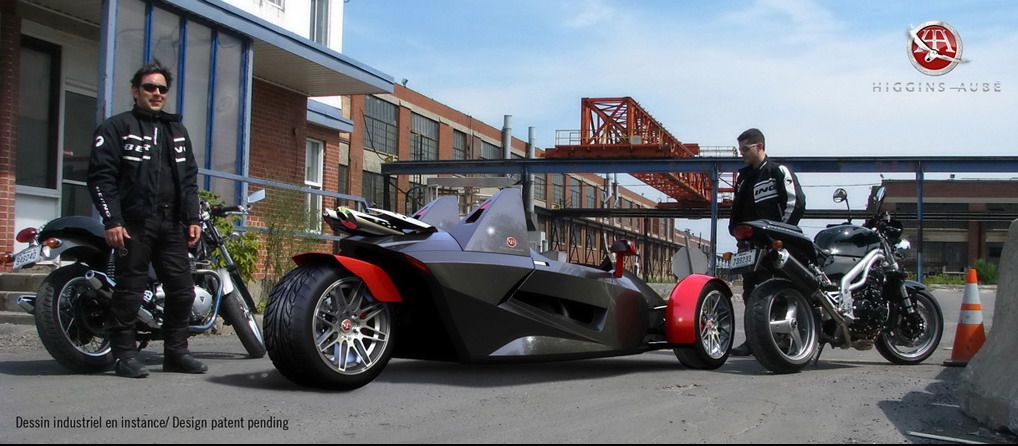The cross breeding of a bike and car has always been a tempting one. The spartan comforts of a bike can propel even the smallest car engine to great speeds (just look at the Ariel Atom->ke564). This may be the idea behind Higgins-Aubé's Energya: a three-wheeled vehicle, designed as a light, high performance vehicle.
Energya is similar to a sports car where the driver and the passenger are seated side-by-side. It is powered by a rear engine mated to a six-speed sequential manual transmission. The dampers slightly protrude through the front cowling, both as a design statement (somewhat motorcycle-like) and for cooling reasons.
Performance targets are set high: achieve 0-60 mph in under 4 seconds and lateral acceleration in excess of 1 G . Expect an engine in the neighborhood of 200 hp and an approximate vehicle weight of 350kg.
Press release
Higgins-Aubé Inc, a young Canadian company, is proud to show early images of its latest creation, the Energya, a three-wheeled vehicle. The Energya™ three-wheeled vehicle, also now know as a motomobile, is designed as a light, high performance vehicle. Similar to a sports car where the driver and the passenger are seated side-by-side, the Energya™ motomobile has a rear engine that drives the single wheel at the back. The vehicle feels, drives and behaves mostly like an open wheels racecar. The vehicle features a distinctive, cutting-edge aggressive design that reflects its level of performance.
Mechanically, the Energya™ motomobile will be powered by a motorcycle engine having a six-speed sequential manual transmission. It will feature an aluminum frame with inboard front suspension using superposed unequal A-arms. The dampers slightly protrude through the front cowling, both as a design statement and for cooling reasons. Particular attention has been given to reduce the weight of each component in order to produce a vehicle that conveys a dynamically thrilling experience. Particular attention has been given to reduce the mass of the non-suspended components and to centralizing most of the mass closer to the vehicle center of gravity for enhancing dynamic performances. The cockpit is typical of a racecar with only the essential instruments for the road. The seats are very supportive, in pure racecar fashion. Innovatively, half-doors are provided to ease access to the cockpit while providing side-impact protection. Convenience has not been neglected with a small storage space under the front cowling.
The advantage of having only three wheels is manifold. First and foremost, a three-wheeled vehicle is considered, in many jurisdictions as a motorcycle. Since the vehicle may do without many of the mandatory systems and components required on an automobile, the motomobile may consequently be made lighter, advantageously influencing its performances. As Higgins-Aubé shares the philosophy of late Colin Chapman, the founder of Lotus Cars™, reducing weight was indeed the cornerstone that led to the choice of this type of vehicle. Furthermore, a three-wheel vehicle having two wheels at the front, contrarily to having a single wheel at the front, is dynamically stable.
Performance targets are set high: achieve 0-100km/h within 4 seconds and lateral acceleration in excess of 1 G . Expect an engine in the neighborhood of 200 hp and an approximate vehicle weight of 350kg. The Energya™ motomobile is aimed at providing exotic car performance at down-to-earth prices.
Styling and design were conducted per state of the art R&D process. "We aimed at solving the main problems related to this compact architecture in sync with engineering. For example, ingress-egress ease and side impact protection were made possible by the use of a half door which also improves general styling by connecting the lower front cowling to the rear fairing with a continuous dynamic line" says Aubé.
Given appropriate financial backing, production units of the Energya™ motomobile could hit the market within 18 months.
As a future step, it is envisioned that the Energya™ motomobile will be offered as an electric vehicle. This will turn the electric-car stereotype on its head, as the same performance objectives will be maintained.


